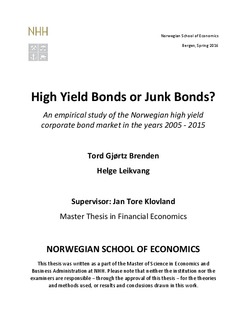| dc.description.abstract | The objective of this thesis is to calculate the returns in the Norwegian high yield bond market between 2005 and 2015. To further strengthen our results, we attempt to find and measure explanatory factors for the differences in realised return. When high yield bonds were first introduced in the market, they were referred to as “junk bonds” to signify the deemed lower quality of the debt. In this thesis, we examine whether “junk” is a more appropriate name based on the return measured against the risk of the investment. To examine this, we calculated the return measured by the internal rate of return on 523 bonds and compared it to the return on Norwegian equities and government securities.
According to our calculations, Norwegian high yield bonds achieved a 0,2% nominal annual return between 2005 and 2015, while the Oslo Stock Exchange Benchmark returned 8,8%. More surprisingly, 5-year Norwegian government bonds returned 4,5% in the same period. Despite low overall returns, 65% of the bonds in our sample had higher returns than 5-year Norwegian government bonds. However, the remaining bonds provided poor returns, which significantly lowered the overall return.
Our result contradicts financial theory that higher risk should lead to higher returns, as high yield bonds carry higher risk than government securities. The relationship between risk and return is well settled in financial theory, which would indicate that Norwegian high yield investors have incorrectly priced the risk associated with these types of bonds. High yield issuance volume increased greatly between 2005 and 2015, and the market composition changed significantly. Further analysis indicates that our findings are impacted by macroeconomic events that occurred within our analysis period, and hence the results are time dependent. In summary, the market is twofold; some bonds ought to be defined as high yield, while others are better defined as “junk”. | nb_NO |
